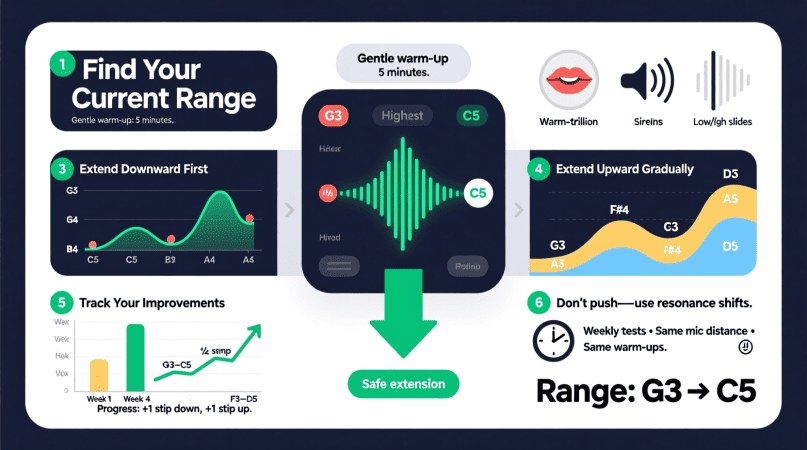
Many singers want to stretch their voices higher or lower but aren’t sure how to do it safely. The challenge is that expanding your vocal range often feels like guesswork—you don’t know if you’re really hitting new notes or just forcing your voice. That’s where a pitch detector becomes a powerful training partner. It shows you exactly which notes you’re singing and whether you’re pushing too far.
Try Our: frequency to note converter
Why Use a Pitch Detector for Range Training?
Traditional range exercises rely on how a note “feels” or how it sounds to your ear. The problem? Our ears can be deceiving, especially when we’re close to our vocal limits. A pitch detector removes the uncertainty by giving:
- Real-time feedback – See the note name and frequency as you sing.
- Baseline mapping – Identify your current highest and lowest comfortable notes.
- Progress tracking – Watch your range grow week by week.
- Safety checks – Spot strain or pitch drift before it becomes a habit.
👉 Try mapping your voice now with the Voice Pitch Analyzer to see your true starting range.
Step 1: Find Your Current Range
- Open a pitch detector.
- Sing downward until your voice becomes unstable. Mark that lowest pitch.
- Repeat upward until you feel tension or strain. Mark that highest pitch.
- This is your baseline vocal range.
Write these notes down—you’ll use them as a reference as you expand.
Step 2: Warm Up Safely
Never attempt range expansion cold. Warmups prepare your cords and help prevent injury:
- Humming at a mid-range pitch.
- Lip trills while sliding up and down a scale.
- Sirens (smooth glides from low to high).
These simple exercises loosen tension so your voice responds better when you explore new notes.
Step 3: Push the Edge Gently
With your baseline set, choose just one note above or below your current limit.
- Hold it lightly for a few seconds.
- Rest and repeat.
- Avoid forcing volume—your goal is comfort and control.
When you watch the pitch detector, look for stability. If the note shakes or drops, take a step back.
Step 4: Use Real-Time Feedback
Range training is about accuracy, not brute force. A singing pitch detector shows when you’re sliding sharp or flat at the edges.
👉 Practice with the Singing Pitch Detector to correct drift instantly and build consistency.
Step 5: Track Your Progress Over Time
Expanding range takes patience. Most singers gain 2–4 semitones over several months with steady training. To stay motivated:
- Log your highest and lowest stable notes weekly.
- Create a simple chart of your improvements.
- Celebrate small wins—each new semitone adds flexibility and confidence.
Safety Tips for Range Expansion
- Never force it. Pain or strain means you’re pushing too far.
- Support with breath. Low, steady airflow keeps notes stable.
- Balance high and low work. Training both ends strengthens your whole voice.
- Rest often. Overuse slows growth more than it helps.
Quick 10-Minute Daily Routine
- Warmup with humming and lip trills (3 minutes)
- Sirens through your current range (2 minutes)
- Target one edge note with pitch detector (3 minutes)
- Finish with comfortable sustained vowels (2 minutes)
Ten minutes daily is enough to see measurable results within weeks.
Pitch Detector is a project by Ornella, blending audio engineering and web technology to deliver precise, real-time pitch detection through your browser. Designed for musicians, producers, and learners who want fast, accurate tuning without installing any software.
